-
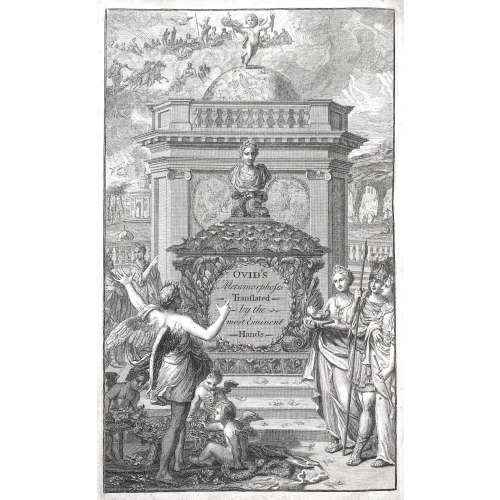 Title: OVID'S | METAMORPHOSES | IN | FIFTEEN BOOKS. | Translated by the most Eminent Hands. | Adorn’d with Sculptures | London: | Printed for Jacob Tonson at Shakespeare’s–Head | over-against Katharine-Street in the Strand. | M DCC XVII. || Physical description: Folio, laid paper, engraved title as frontispiece, letterpress title-page, portrait of the dedicatee, the Princess of Wales, engraved by George Vertue (British, 1684 – 1756) after Sir Godfrey Kneller (German, 1646 – 1723), [4] – dedication with headpiece vignette engraved by Elisha Kirkall (British, 1682 – 1742) after Peter Berchet (French, 1659 – 1720 London), [i]-xx – preface, [4] – contents, 1-548; collation: π3 a-f2, B-Zzzzzz2, +15 full-paged engravings, one heading each book; bound in full contemporary tan English calf blind-tooled with a darker panel, raised bands, crimson label with gilt lettering, sprinkled compartments with blind tooling, rebacked, later endpapers, 15 1/4 x 9 1/2 in (39.5 x 26 x 5 cm). Contributors: Author: Ovid (Roman, 43 B.C. – A.D. 17) Translator: Sir Samuel Garth (British, 1661 – 1719) Translator: John Dryden (British, 1631 – 1700) Translator: Joseph Addison (British, 1672 – 1719) Translator: John Gay (British, 1685 – 1732) Dedicatee / Sitter: Caroline Wilhelmina of Brandenburg-Ansbach, Princess of Wales, Queen of England (German-British, 1683 – 1737) Engraver: Elisha Kirkall (British, 1682 – 1742) Artist: Peter Berchet (French-British, 1659 – 1720) Artist: Sir Godfrey Kneller (German, 1646 – 1723) Engraver: George Vertue (British, 1684 – 1756) Engraver: Louis Du Guernier, the younger (French, 1677 – 1716) Engraver: Michael Vandergucht (Flemish, 1660 – 1725) Engraver: Elisha Kirkall (British, 1682 – 1742) Engraver: R. Smith (British, fl. early 18th century) Engraver: Matthys Pool (Dutch, 1670 – c. 1732) Publisher: Jacob Tonson, the Elder (British, 1655 – 1736)
Title: OVID'S | METAMORPHOSES | IN | FIFTEEN BOOKS. | Translated by the most Eminent Hands. | Adorn’d with Sculptures | London: | Printed for Jacob Tonson at Shakespeare’s–Head | over-against Katharine-Street in the Strand. | M DCC XVII. || Physical description: Folio, laid paper, engraved title as frontispiece, letterpress title-page, portrait of the dedicatee, the Princess of Wales, engraved by George Vertue (British, 1684 – 1756) after Sir Godfrey Kneller (German, 1646 – 1723), [4] – dedication with headpiece vignette engraved by Elisha Kirkall (British, 1682 – 1742) after Peter Berchet (French, 1659 – 1720 London), [i]-xx – preface, [4] – contents, 1-548; collation: π3 a-f2, B-Zzzzzz2, +15 full-paged engravings, one heading each book; bound in full contemporary tan English calf blind-tooled with a darker panel, raised bands, crimson label with gilt lettering, sprinkled compartments with blind tooling, rebacked, later endpapers, 15 1/4 x 9 1/2 in (39.5 x 26 x 5 cm). Contributors: Author: Ovid (Roman, 43 B.C. – A.D. 17) Translator: Sir Samuel Garth (British, 1661 – 1719) Translator: John Dryden (British, 1631 – 1700) Translator: Joseph Addison (British, 1672 – 1719) Translator: John Gay (British, 1685 – 1732) Dedicatee / Sitter: Caroline Wilhelmina of Brandenburg-Ansbach, Princess of Wales, Queen of England (German-British, 1683 – 1737) Engraver: Elisha Kirkall (British, 1682 – 1742) Artist: Peter Berchet (French-British, 1659 – 1720) Artist: Sir Godfrey Kneller (German, 1646 – 1723) Engraver: George Vertue (British, 1684 – 1756) Engraver: Louis Du Guernier, the younger (French, 1677 – 1716) Engraver: Michael Vandergucht (Flemish, 1660 – 1725) Engraver: Elisha Kirkall (British, 1682 – 1742) Engraver: R. Smith (British, fl. early 18th century) Engraver: Matthys Pool (Dutch, 1670 – c. 1732) Publisher: Jacob Tonson, the Elder (British, 1655 – 1736) -
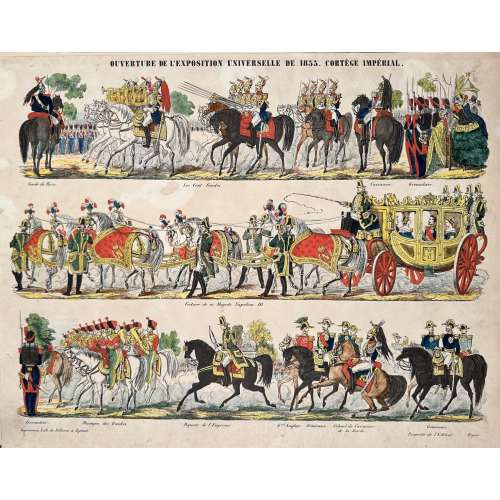 Hand-coloured woodcut on wove paper, 366 x 460 mm; black ink stamp “5057” to reverse. Caption cartoon in 2 tiers. Top: OUVERTURE DE 'EXPOSITION UNIVERSELLE DE 1855. CORTÈGE IMPÉRIAL. Captions top to bottom: Garde de Paris. — Les Cent Gardes. — Cuirassier. — Grenadiers. Middle: Voiture de sa Majesté Napoléon III. | Bottom: Grenadier. — Musique des Guides. — Piqueur de l’Empereur. — Gral Anglais — Généraux — Colonel de Cuirassiers | de la Garde — Généraux. Below left: Imprimerie Lith. de Pellerin, à Épinal; right: Propriété de l’Éditeur. Déposé. Jean Charles Pellerin (French, 1756 – 1836) – printer/publisher.
Hand-coloured woodcut on wove paper, 366 x 460 mm; black ink stamp “5057” to reverse. Caption cartoon in 2 tiers. Top: OUVERTURE DE 'EXPOSITION UNIVERSELLE DE 1855. CORTÈGE IMPÉRIAL. Captions top to bottom: Garde de Paris. — Les Cent Gardes. — Cuirassier. — Grenadiers. Middle: Voiture de sa Majesté Napoléon III. | Bottom: Grenadier. — Musique des Guides. — Piqueur de l’Empereur. — Gral Anglais — Généraux — Colonel de Cuirassiers | de la Garde — Généraux. Below left: Imprimerie Lith. de Pellerin, à Épinal; right: Propriété de l’Éditeur. Déposé. Jean Charles Pellerin (French, 1756 – 1836) – printer/publisher. -
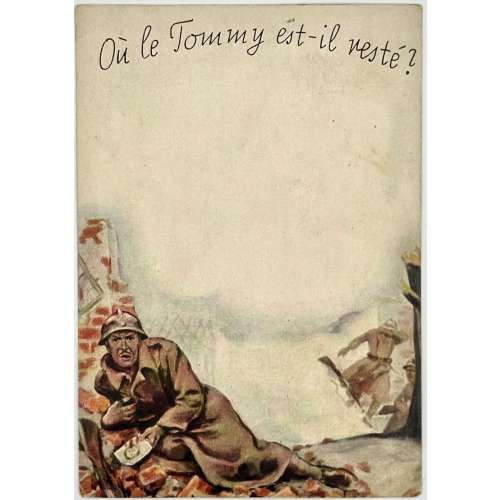 One of a series of six anti-allies propaganda cards, printed in colour, inscribed Ou le Tommy est-il resté? (Where did Tommy stay?), where Tommy is slang for a common soldier in the British Army. The postcards visibly depict French soldiers who fight and die at the western front, while the covert watermark image shows a British military having fun in a bordello. Those cards were printed in the Third Reich for France and dropped from aeroplanes to motivate French soldiers to fight against the British. Size: 149 x 104 mm
One of a series of six anti-allies propaganda cards, printed in colour, inscribed Ou le Tommy est-il resté? (Where did Tommy stay?), where Tommy is slang for a common soldier in the British Army. The postcards visibly depict French soldiers who fight and die at the western front, while the covert watermark image shows a British military having fun in a bordello. Those cards were printed in the Third Reich for France and dropped from aeroplanes to motivate French soldiers to fight against the British. Size: 149 x 104 mm -
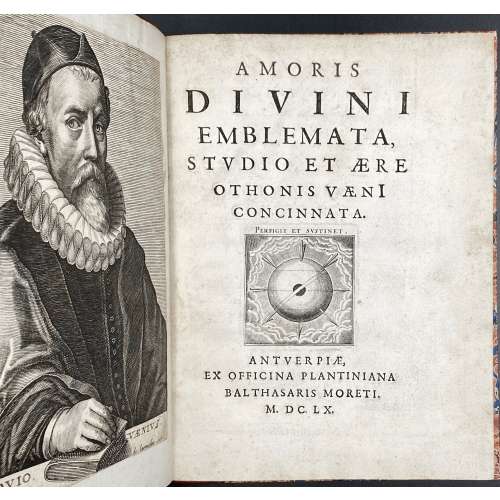 Amoris Divini Emblemata, Studio Et Aere Othonis Vaeni Concinata. — Antverpiae: Ex Officina Plantiniana Balthasaris Moreti, MDCLX [1660]. — pp.: [1] (Van Veen port.), [1] title, [2] (Isabella port.), 3-127 [1], 60 illustr. — 2nd impression. Octavius Vaenius, a.k.a. Otto Vaenius or Otto Van Veen (c. 1556-1629) was Rubens's last and most influential teacher. The Amoris divini emblemata was first published in 1615 by Nutius & Meursius in Antwerp. Vaenius’s book was to influence Herman Hugo's Pia desideria (LIB-1657.2018). Book structure: On frontispiece, trimmed and mounted portrait of Octavius Vaenius painted by his daughter Gertruida van Veen (signed Gertrudis filia) and engraved by Nicolas de Larmessin. Trimmed portrait of the Infanta Isabella Clara of Austria (1566 – 1633) pained by Peter Paul Rubens and engraved by Jan de Leeuw mounted to title verso. 60 engraved plates with emblems are on recto pages with facing texts: Latin quotations from Bible and Fathers, Spanish verses by Alphonso de Ledesma, Dutch by Vaenius and French by Carolus Philippus Hattron (d. 1632). Rebound in the mid-19th century in brown quarter Morocco with blind marbled boards and gilt lettering to spine. Inscription in ink on verso to van Veen portrait: "I bought this volume with the portraits inserted at the sale of the library of my uncle Samuel Rogers, Esq." Signed: "Frederick Sharpe, 1856". Frederick Sharpe (born was a son of Samuel Sharpe (1799–1881), the nephew of Samuel Rogers (1763–1855), a celebrated English poet. Size: 23.3 x 17.9 cm. Ref.: Emblem Project Utrecht (with an explanation of all the emblems); PETER BOOTHUYGENS: Similar or Dissimilar Loves?
Amoris Divini Emblemata, Studio Et Aere Othonis Vaeni Concinata. — Antverpiae: Ex Officina Plantiniana Balthasaris Moreti, MDCLX [1660]. — pp.: [1] (Van Veen port.), [1] title, [2] (Isabella port.), 3-127 [1], 60 illustr. — 2nd impression. Octavius Vaenius, a.k.a. Otto Vaenius or Otto Van Veen (c. 1556-1629) was Rubens's last and most influential teacher. The Amoris divini emblemata was first published in 1615 by Nutius & Meursius in Antwerp. Vaenius’s book was to influence Herman Hugo's Pia desideria (LIB-1657.2018). Book structure: On frontispiece, trimmed and mounted portrait of Octavius Vaenius painted by his daughter Gertruida van Veen (signed Gertrudis filia) and engraved by Nicolas de Larmessin. Trimmed portrait of the Infanta Isabella Clara of Austria (1566 – 1633) pained by Peter Paul Rubens and engraved by Jan de Leeuw mounted to title verso. 60 engraved plates with emblems are on recto pages with facing texts: Latin quotations from Bible and Fathers, Spanish verses by Alphonso de Ledesma, Dutch by Vaenius and French by Carolus Philippus Hattron (d. 1632). Rebound in the mid-19th century in brown quarter Morocco with blind marbled boards and gilt lettering to spine. Inscription in ink on verso to van Veen portrait: "I bought this volume with the portraits inserted at the sale of the library of my uncle Samuel Rogers, Esq." Signed: "Frederick Sharpe, 1856". Frederick Sharpe (born was a son of Samuel Sharpe (1799–1881), the nephew of Samuel Rogers (1763–1855), a celebrated English poet. Size: 23.3 x 17.9 cm. Ref.: Emblem Project Utrecht (with an explanation of all the emblems); PETER BOOTHUYGENS: Similar or Dissimilar Loves? -
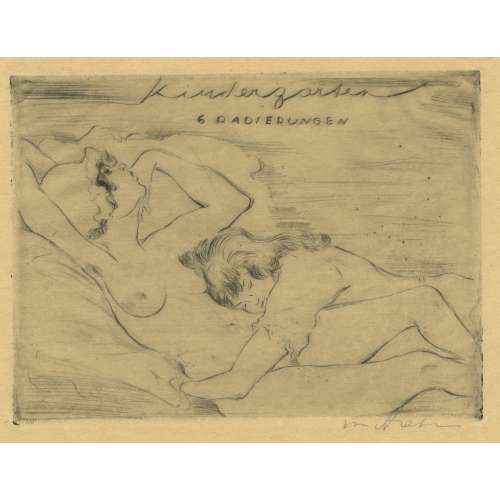 NEWFlapped portfolio 330 x 245 mm, blue cloth spine over crimson paper boards, contains six loose etched plates printed on laid paper, each in a passepartout 320 x 235 mm, incl. title sheet 175 x 210 mm with plate mark 120 x 165 mm, and five other sheets of various sizes (220-250 x 163-215 mm). Contributors: Schoff, Otto (German, 1888 – 1938) Gurlitt, Fritz (Austrian-German, 1854 – 1893) According to many sources, there should be six etchings besides the title-page. Another set that belonged to Hans-Jürgen Döpp and was sold in Berlin on May 10, 2024, has an additional image:
NEWFlapped portfolio 330 x 245 mm, blue cloth spine over crimson paper boards, contains six loose etched plates printed on laid paper, each in a passepartout 320 x 235 mm, incl. title sheet 175 x 210 mm with plate mark 120 x 165 mm, and five other sheets of various sizes (220-250 x 163-215 mm). Contributors: Schoff, Otto (German, 1888 – 1938) Gurlitt, Fritz (Austrian-German, 1854 – 1893) According to many sources, there should be six etchings besides the title-page. Another set that belonged to Hans-Jürgen Döpp and was sold in Berlin on May 10, 2024, has an additional image: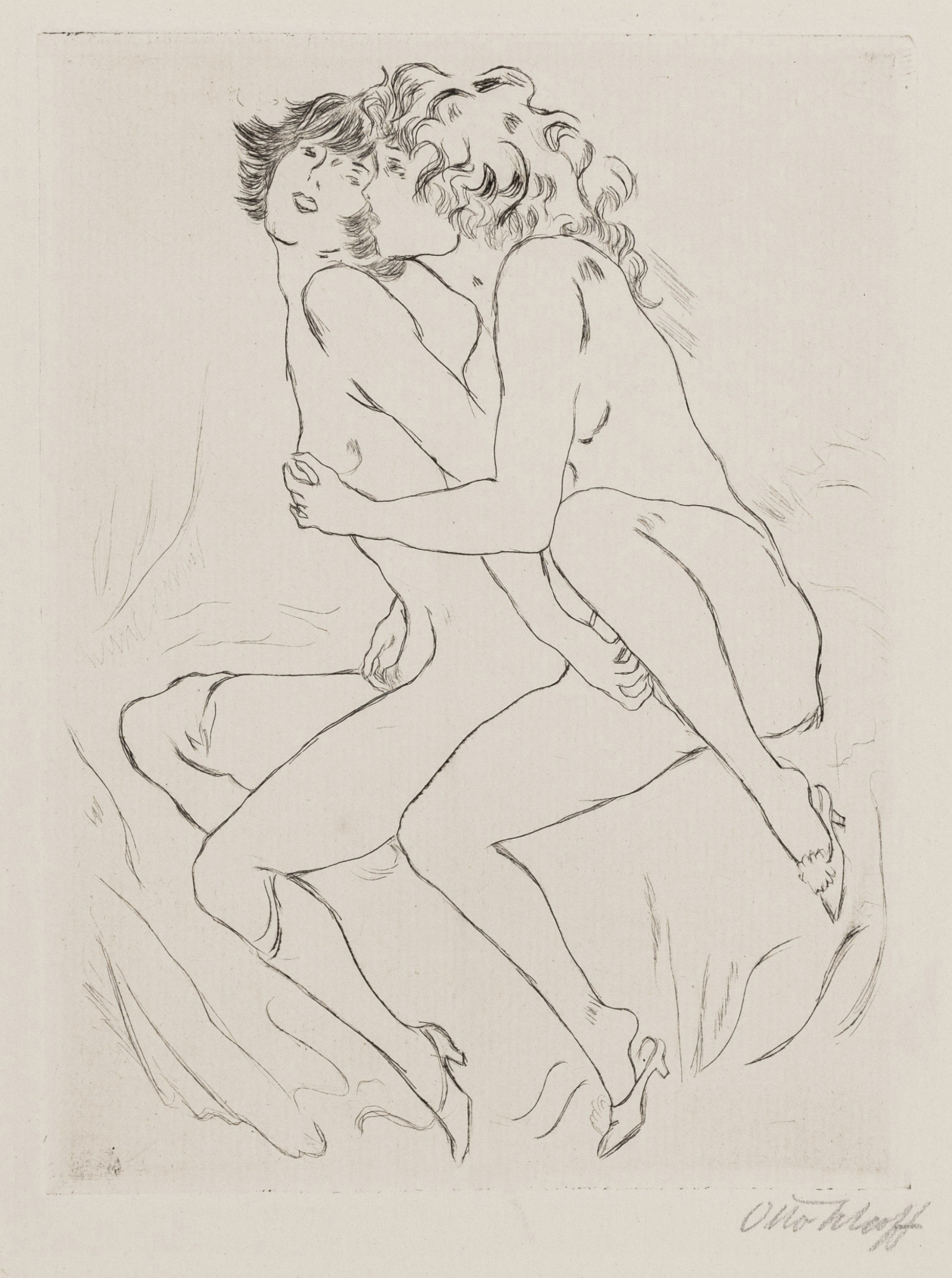 And another '7th plate' can be found at honesterotica.com:
And another '7th plate' can be found at honesterotica.com:
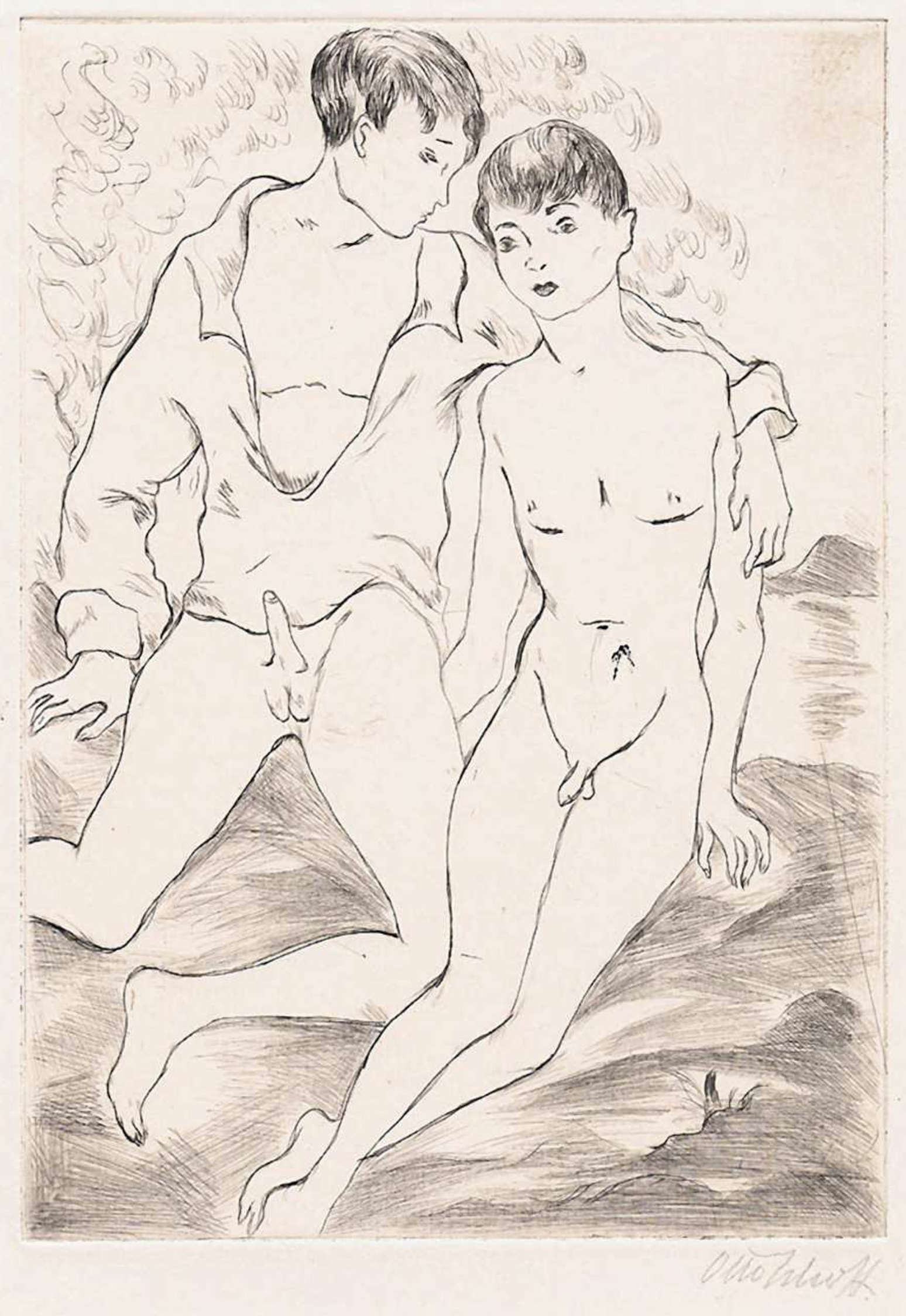 However, I believe the six etchings mentioned at t.p. are all in the portfolio, including t.p. The two images above are probably parts of other sets.
However, I believe the six etchings mentioned at t.p. are all in the portfolio, including t.p. The two images above are probably parts of other sets.
-
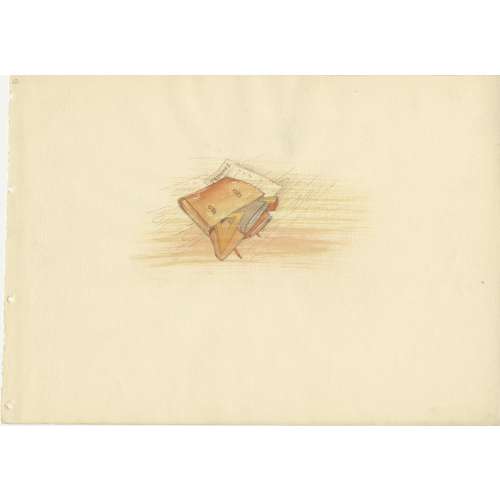 NEWZeugnis (Grade book) – a set of fifteen plates, incl. the title page and the colophon, that tells the story of a schoolgirl whose parents spanked her for not being a good student. Watercolour and ink on 244 x 344 mm cream laid paper with Hahnemühle's watermark (rooster with a shield), signed and dated in manuscript on the last page (colophon) "O. R. SCHATZ | 1954 | X", unbound (disbound), with four binding holes in the left margin of each sheet; no boards. Artist: Otto Rudolf Schatz (Austrian, 1900 – 1961).
NEWZeugnis (Grade book) – a set of fifteen plates, incl. the title page and the colophon, that tells the story of a schoolgirl whose parents spanked her for not being a good student. Watercolour and ink on 244 x 344 mm cream laid paper with Hahnemühle's watermark (rooster with a shield), signed and dated in manuscript on the last page (colophon) "O. R. SCHATZ | 1954 | X", unbound (disbound), with four binding holes in the left margin of each sheet; no boards. Artist: Otto Rudolf Schatz (Austrian, 1900 – 1961). -
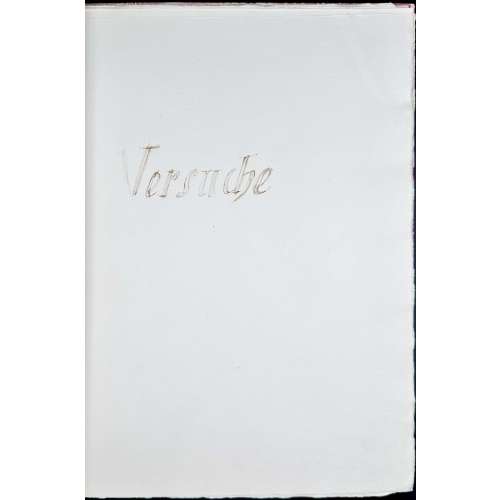 NEWAlbum of 10 watercolour drawings on thick wove paper sheets 315 x 245 mm, incl. title and colophon, plus one blank sheet before the title page, in Japanese stab binding — cardboard covers with stripes and ribbons marbling, sewed with blue thread. Signed and dated on the rearmost sheet. Versuch (German)— trial, experiment, test, attempt. Artist: Otto Rudolf Schatz (Austrian, 1900 – 1961).
NEWAlbum of 10 watercolour drawings on thick wove paper sheets 315 x 245 mm, incl. title and colophon, plus one blank sheet before the title page, in Japanese stab binding — cardboard covers with stripes and ribbons marbling, sewed with blue thread. Signed and dated on the rearmost sheet. Versuch (German)— trial, experiment, test, attempt. Artist: Otto Rudolf Schatz (Austrian, 1900 – 1961). -
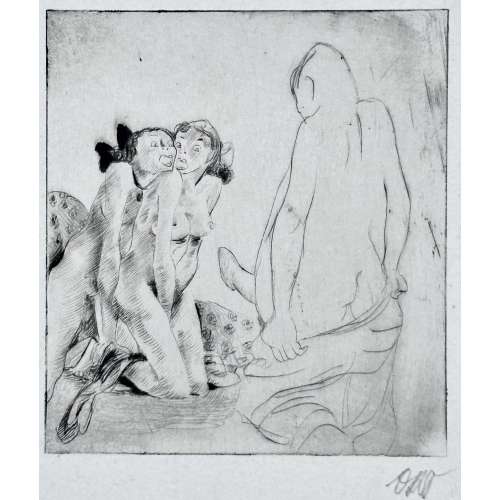 NEWTwelve loose drypoint plates on cream cardstock of different sizes (sheet, platemark, signature in pencil to margin) SVE-0584.2024-1: 185 x 183 mm; 103 x 80 mm –– SVE-0584.2024-2: 138 x 103 mm; 103 x 82 mm; ORS SVE-0584.2024-3: 201 x 142 mm; 104 x 82 mm; ORS SVE-0584.2024-4: 200 x 144 mm; 103 x 80 mm; ORS SVE-0584.2024-5: 158 x 110 mm; 102 x 81 mm; ORS SVE-0584.2024-6: 141 x 103 mm; 103 x 82 mm; ORS SVE-0584.2024-7: 200 x 141 mm; 103 x 82 mm; ORS SVE-0584.2024-8: 230 x 207 mm; 122x 100 mm; ORS SVE-0584.2024-9: 205 x 155 mm; 132 x 102 mm; ORS SVE-0584.2024-10: 200 x 230 mm; 101 x 131 mm; ORS SVE-0584.2024-11: 230 x 206 mm; 80 x 130 mm; ORS SVE-0584.2024-12: 228 x 206 mm; 100 x 91 mm; ORS Artist: Otto Rudolf Schatz (Austrian, 1900 – 1961).
NEWTwelve loose drypoint plates on cream cardstock of different sizes (sheet, platemark, signature in pencil to margin) SVE-0584.2024-1: 185 x 183 mm; 103 x 80 mm –– SVE-0584.2024-2: 138 x 103 mm; 103 x 82 mm; ORS SVE-0584.2024-3: 201 x 142 mm; 104 x 82 mm; ORS SVE-0584.2024-4: 200 x 144 mm; 103 x 80 mm; ORS SVE-0584.2024-5: 158 x 110 mm; 102 x 81 mm; ORS SVE-0584.2024-6: 141 x 103 mm; 103 x 82 mm; ORS SVE-0584.2024-7: 200 x 141 mm; 103 x 82 mm; ORS SVE-0584.2024-8: 230 x 207 mm; 122x 100 mm; ORS SVE-0584.2024-9: 205 x 155 mm; 132 x 102 mm; ORS SVE-0584.2024-10: 200 x 230 mm; 101 x 131 mm; ORS SVE-0584.2024-11: 230 x 206 mm; 80 x 130 mm; ORS SVE-0584.2024-12: 228 x 206 mm; 100 x 91 mm; ORS Artist: Otto Rudolf Schatz (Austrian, 1900 – 1961). -
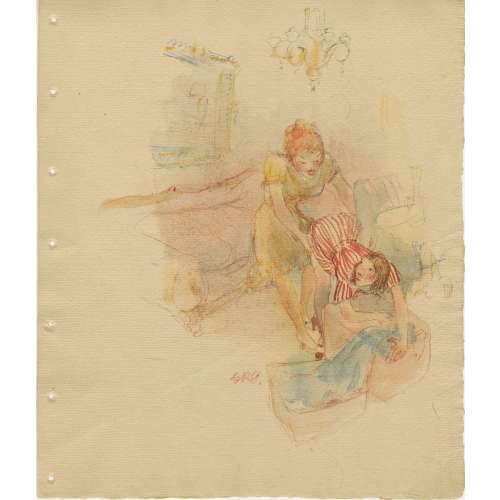 NEWWatercolour, pen and ink on laid paper 313 x 265 mm; each monogrammed "ORS” in manuscript; seven ex-album holes along the left margin. Artist: Otto Rudolf Schatz (Austrian, 1900 – 1961).
NEWWatercolour, pen and ink on laid paper 313 x 265 mm; each monogrammed "ORS” in manuscript; seven ex-album holes along the left margin. Artist: Otto Rudolf Schatz (Austrian, 1900 – 1961). -
 NEWDrypoint on cream cardstock 230 x 206 mm with plate mark 101 x 112 mm, signed 'ORS' in pencil on the margin below the plate mark. Artist: Otto Rudolf Schatz (Austrian, 1900 – 1961).
NEWDrypoint on cream cardstock 230 x 206 mm with plate mark 101 x 112 mm, signed 'ORS' in pencil on the margin below the plate mark. Artist: Otto Rudolf Schatz (Austrian, 1900 – 1961). -
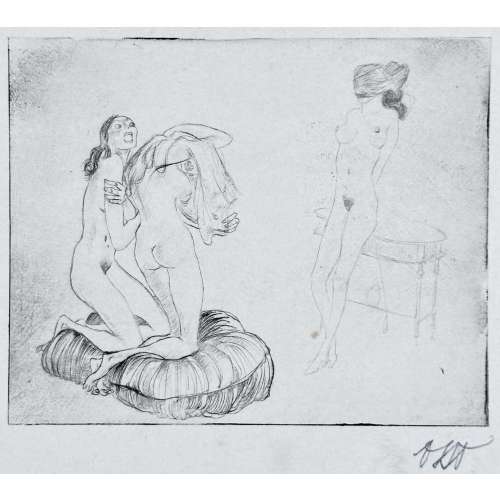 NEWDrypoint on cream cardstock 160 x 212 mm with plate mark 97 x 120 mm, signed 'ORS' in pencil on the margin below the plate mark. Artist: Otto Rudolf Schatz (Austrian, 1900 – 1961).
NEWDrypoint on cream cardstock 160 x 212 mm with plate mark 97 x 120 mm, signed 'ORS' in pencil on the margin below the plate mark. Artist: Otto Rudolf Schatz (Austrian, 1900 – 1961). -
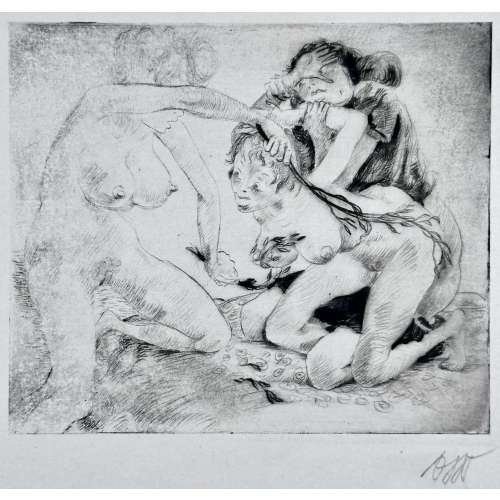 NEWDrypoint on cream cardstock 230 x 207 mm with plate mark 102 x 120 mm, signed 'ORS' in pencil on the margin below the plate mark. Artist: Otto Rudolf Schatz (Austrian, 1900 – 1961).
NEWDrypoint on cream cardstock 230 x 207 mm with plate mark 102 x 120 mm, signed 'ORS' in pencil on the margin below the plate mark. Artist: Otto Rudolf Schatz (Austrian, 1900 – 1961). -
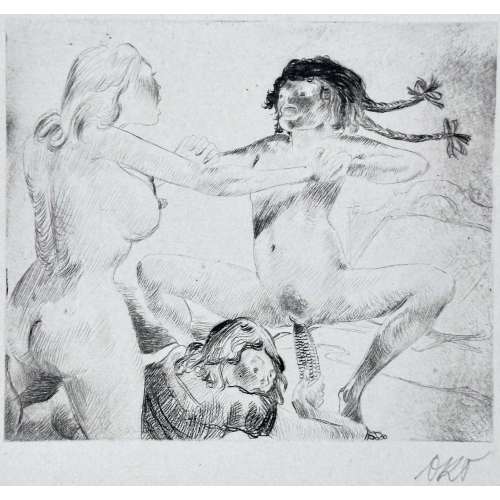 NEWDrypoint with plate mark 90 x 105 mm on cream cardstock in two states: (1) two copies 155 x 230 mm, signed 'ORS' in pencil on the margin below the plate mark. (2) 155 x x 225 mm signed 'ORS' in pencil on the margin below the plate mark and with the letter 'd' in pencil above the plate mark. Artist: Otto Rudolf Schatz (Austrian, 1900 – 1961).
NEWDrypoint with plate mark 90 x 105 mm on cream cardstock in two states: (1) two copies 155 x 230 mm, signed 'ORS' in pencil on the margin below the plate mark. (2) 155 x x 225 mm signed 'ORS' in pencil on the margin below the plate mark and with the letter 'd' in pencil above the plate mark. Artist: Otto Rudolf Schatz (Austrian, 1900 – 1961). -
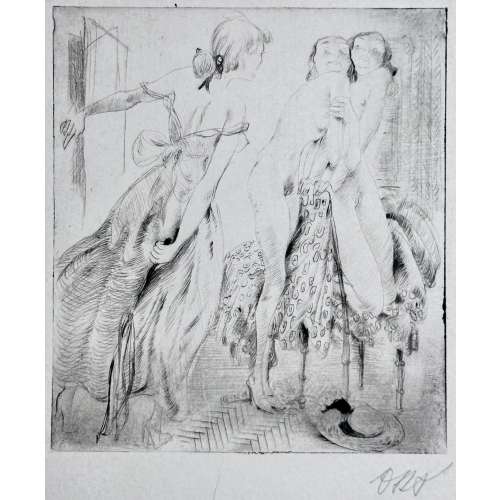 NEWSanguine drypoint with plate mark 102 x 90 mm on cream cardstock in two states: (1) 227 x 203 mm, signed 'ORS' in pencil on the margin below the plate mark. (2) 230 x x 203 mm signed 'ORS' in pencil on the margin below the plate mark and with the letter 'd' in pencil above the plate mark. Artist: Otto Rudolf Schatz (Austrian, 1900 – 1961).
NEWSanguine drypoint with plate mark 102 x 90 mm on cream cardstock in two states: (1) 227 x 203 mm, signed 'ORS' in pencil on the margin below the plate mark. (2) 230 x x 203 mm signed 'ORS' in pencil on the margin below the plate mark and with the letter 'd' in pencil above the plate mark. Artist: Otto Rudolf Schatz (Austrian, 1900 – 1961). -
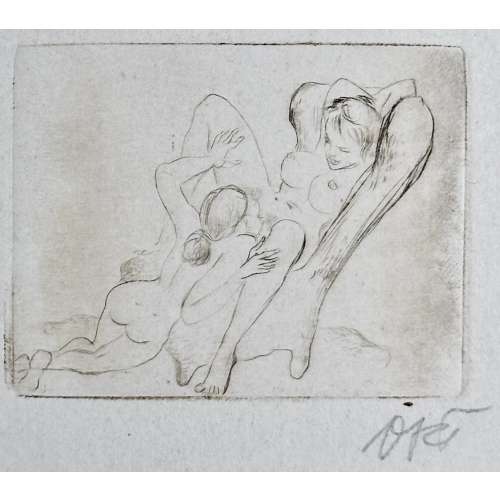 NEWSepia drypoint with plate mark 55 x 70 mm on cream cardstock in two states: (1) 115 x 155 mm, unsigned (2) 115 x 155 mm, signed 'ORS' in pencil on the margin below the plate mark. Artist: Otto Rudolf Schatz (Austrian, 1900 – 1961).
NEWSepia drypoint with plate mark 55 x 70 mm on cream cardstock in two states: (1) 115 x 155 mm, unsigned (2) 115 x 155 mm, signed 'ORS' in pencil on the margin below the plate mark. Artist: Otto Rudolf Schatz (Austrian, 1900 – 1961). -
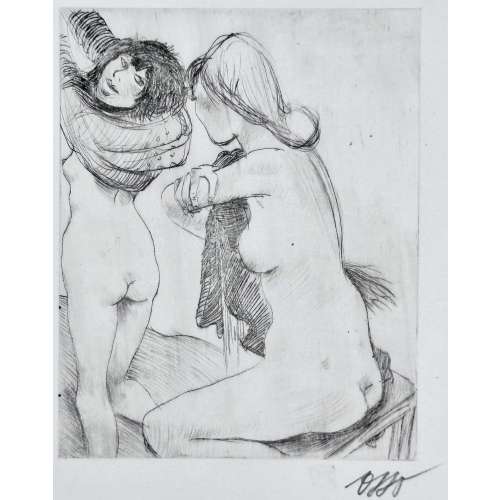 NEWNine loose drypoint plates on cream cardstock of different sizes (sheet, platemark, signature in pencil to margin) SVE-0585.2024-1: 183 x 183 mm; 101 x 80 mm; ORS SVE-0585.2024-2: 219 x 195 mm; 102 x 80 mm; –– SVE-0585.2024-3: 183 x 187 mm; 102 x 84 mm; –– SVE-0585.2024-4: 183 x 184 mm; 103 x 81 mm; ORS SVE-0585.2024-5: 183 x 186 mm; 102 x 80 mm; ORS SVE-0585.2024-6: 220 x 194 mm; 102 x 83 mm; ORS SVE-0585.2024-7: 158 x 108 mm; 101 x 79 mm; ORS SVE-0585.2024-8: 110 x 158 mm; 83 x 102 mm; –– SVE-0585.2024-9: 158 x 109 mm; 101 x 81 mm; ORS Artist: Otto Rudolf Schatz (Austrian, 1900 – 1961).
NEWNine loose drypoint plates on cream cardstock of different sizes (sheet, platemark, signature in pencil to margin) SVE-0585.2024-1: 183 x 183 mm; 101 x 80 mm; ORS SVE-0585.2024-2: 219 x 195 mm; 102 x 80 mm; –– SVE-0585.2024-3: 183 x 187 mm; 102 x 84 mm; –– SVE-0585.2024-4: 183 x 184 mm; 103 x 81 mm; ORS SVE-0585.2024-5: 183 x 186 mm; 102 x 80 mm; ORS SVE-0585.2024-6: 220 x 194 mm; 102 x 83 mm; ORS SVE-0585.2024-7: 158 x 108 mm; 101 x 79 mm; ORS SVE-0585.2024-8: 110 x 158 mm; 83 x 102 mm; –– SVE-0585.2024-9: 158 x 109 mm; 101 x 81 mm; ORS Artist: Otto Rudolf Schatz (Austrian, 1900 – 1961). -
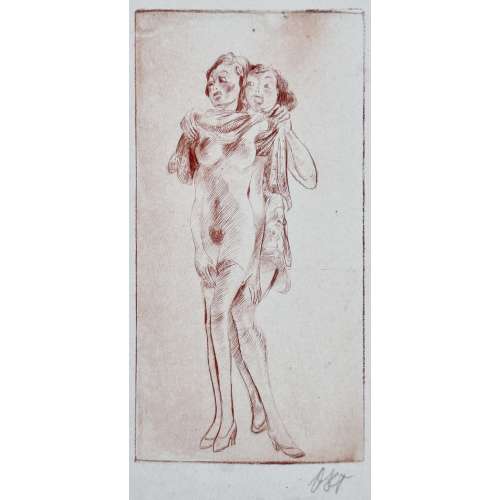 NEWSanguine drypoint on cream cardstock 230 x 155 mm with platemark 153 x 79 mm, monogrammed "ORS" in pencil. Inscription in pencil to bottom: "Letzter Abzug x. 49". Artist: Otto Rudolf Schatz (Austrian, 1900 – 1961).
NEWSanguine drypoint on cream cardstock 230 x 155 mm with platemark 153 x 79 mm, monogrammed "ORS" in pencil. Inscription in pencil to bottom: "Letzter Abzug x. 49". Artist: Otto Rudolf Schatz (Austrian, 1900 – 1961). -
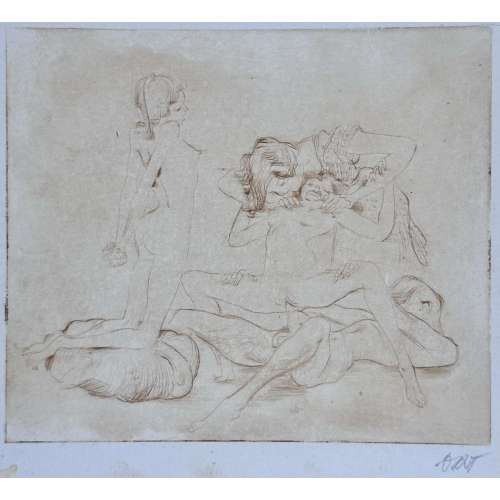 NEWSanguine drypoint with platemark 130 x 150 mm on cream cardstock in two states: (1) 209 x 212 mm, signed 'ORS' in pencil on the margin below the platemark. (2) 206-214 x x 224-228 mm with letter 'd' in pencil above the platemark. Artist: Otto Rudolf Schatz (Austrian, 1900 – 1961).
NEWSanguine drypoint with platemark 130 x 150 mm on cream cardstock in two states: (1) 209 x 212 mm, signed 'ORS' in pencil on the margin below the platemark. (2) 206-214 x x 224-228 mm with letter 'd' in pencil above the platemark. Artist: Otto Rudolf Schatz (Austrian, 1900 – 1961).


